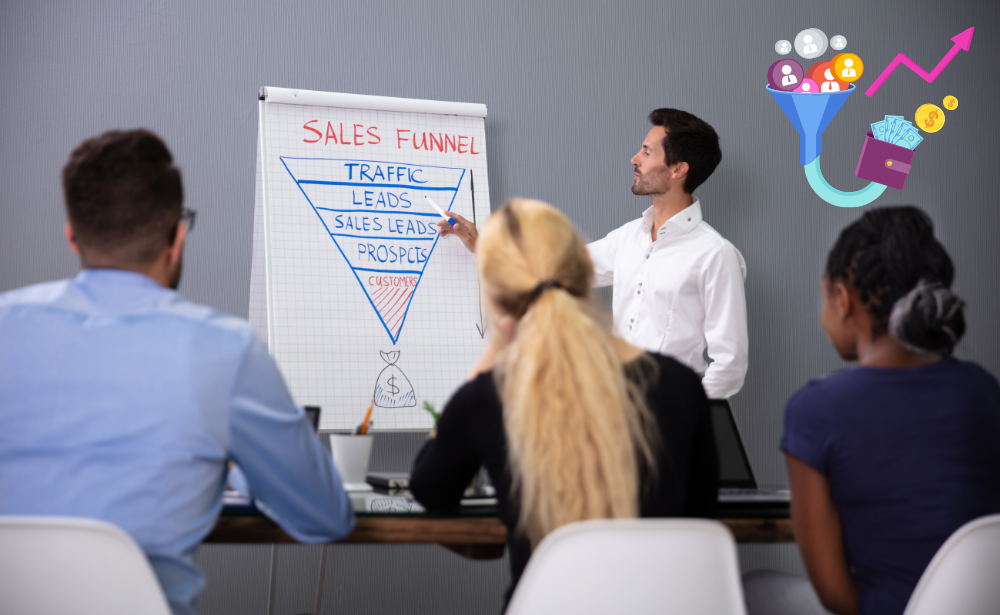If you’re running a business, the sales funnel is one of the most important concepts to master. It’s not just a series of steps leading your customers from initial contact to a sale. It’s a map of how they think, feel, and decide. When you understand how customers move through the sales funnel, you get to see what drives their behaviour at each stage and how you can guide them towards making a purchase.
But here’s the thing—people don’t make decisions in a straight line. There are emotions, pain points, and mental roadblocks that get in the way. This is where sales funnel psychology comes into play. You need to know not only what your customers want but also why they want it and what might stop them from acting.
Let’s get into the details of how you can truly get into your customers’ minds, influence their journey, and convert them into loyal buyers.
Key Points to Keep in Mind
- Learn to recognize customer pain points so you can speak directly to their needs throughout each stage of the sales funnel.
- Use emotional triggers like FOMO (Fear of Missing Out) or nostalgia to create connections that matter.
- Build trust by being transparent, authentic, and consistent in all your customer interactions.
- Rely on social proof like testimonials or reviews to show that others trust your brand, which in turn influences potential customers.
- Make your messaging clear and easy to follow with well-placed calls to action so customers know exactly what steps to take next.
Breaking Down the Sales Funnel
A sales funnel is essentially a way to understand how people go from hearing about your product or service to actually buying it. It’s called a “funnel” because, like an inverted triangle, it narrows down as customers move from the awareness stage to the decision stage. Fewer people make it to the final step than those who entered at the top, but the goal is to move as many of them as possible through each stage.
Here’s a look at the four main stages:
- Awareness Stage: This is the moment your customer first learns about your brand or product. It could be through an ad, social media, a Google search, or even word of mouth. Your job here is to grab their attention. The focus should be on building brand awareness and sparking initial interest.
- Interest Stage: Once you’ve got their attention, the next step is keeping them interested. This is where they start looking into your brand more deeply, comparing it to competitors, or seeking more information. Here, you need to provide valuable resources—whether that’s blog posts, white papers, videos, or case studies.
- Consideration Stage: At this stage, your prospects are weighing their options. They’re aware of what you offer but might still be comparing you to competitors. You’ll need to prove that your product or service is the best fit for their needs. This is where social proof like testimonials, product demos, and detailed product descriptions make all the difference.
- Decision Stage: This is the point where your prospect is ready to buy. Don’t lose them now. Offer reassurance, make the checkout process simple, and eliminate any doubts they might have. A solid money-back guarantee or customer support option can be the final push they need.
To manage this process effectively, tools like HubSpot, ClickFunnels, and Mailchimp are invaluable for tracking where customers are in the funnel and how to nudge them forward.
The Role of Emotions in Buying Decisions
You may think people make purchases based on logic, but emotions are often the real driving force behind a decision. Sure, someone might logically need a new pair of shoes, but it’s the excitement of a new style, the comfort factor, or even the status that comes with a particular brand that closes the deal.
If you can tap into those emotions, your marketing will resonate more deeply. People will feel connected to your brand, not just for the product you’re offering, but for how it makes them feel.
Emotional Triggers That Influence Purchases
- FOMO (Fear of Missing Out): When customers believe there’s a limited-time offer, a sale about to end, or an exclusive deal, it lights a fire under them. They don’t want to miss out, so they act quickly. You’ve probably seen this tactic in flash sales or countdown timers.
- Nostalgia: People love to reminisce. If your product or brand can tie into positive memories, customers are more likely to purchase. For example, brands like Coca-Cola often leverage nostalgia by evoking childhood memories or more straightforward times.
- Trust: This is a powerful emotional driver. Customers need to trust not only that your product will work but also that you’re a reliable company. Use testimonials, reviews, and real stories from satisfied customers to build trust. Platforms like Trustpilot and Yelp are great tools for collecting and displaying customer feedback.
- Exclusivity: People love to feel special. Limited-edition products or members-only access can drive purchases by making customers feel like they’re part of an exclusive group.
HubSpot Marketing and Neil Patel’s Blog are excellent resources for learning more about how to integrate emotional triggers into your marketing.
The Importance of Building Trust
No matter how great your product is, customers won’t buy from you if they don’t trust you. Trust is the foundation of any lasting relationship, and it’s something that can’t be faked.
Authenticity is the key to building trust. People can tell when a brand isn’t being genuine. Instead of trying to manipulate your customers, focus on being open and transparent about what your company stands for and what it offers. Share your values, tell your story, and don’t be afraid to show the human side of your brand.
Simple Ways to Build Trust:
- Transparency: Be clear about pricing, shipping times, and what customers can expect from your product. If there are delays or issues, let customers know. Hiding things will only lead to frustration and lost trust.
- Consistency: Every interaction a customer has with your brand should feel the same. Whether it’s your website, social media, or customer service, make sure everything reflects your brand’s voice and values.
- Social Proof: Show potential customers that others already trust you. Use reviews, testimonials, and case studies to demonstrate the success others have had with your product. Trustpilot and Yelp are perfect tools for gathering and displaying this social proof.
- Engagement: Respond to questions, comments, and feedback—whether good or bad. Engaging with your customers shows that you care about their experience and are willing to make things right when something goes wrong.
Building trust takes time, but once you’ve earned it, customers will come back to you again and again.
Understanding and Solving Customer Pain Points
Customers come to your product or service because they have a problem that needs solving. These problems are often called pain points, and identifying them is crucial if you want to tailor your messaging and offer solutions that resonate.
Let’s look at some common customer pain points:
Common Pain Points and How to Address Them:
| Pain Point | Customer Thought | How You Can Solve It |
|---|---|---|
| Time Constraints | “I don’t have time for this.” | Offer solutions that save time. Highlight features that automate tasks or simplify routines. Trello is an excellent example of a tool that solves this problem by organizing tasks efficiently. |
| Financial Concerns | “I can’t afford this right now.” | Emphasize the value and long-term benefits of your product. Offer flexible payment plans or discounts to make the decision easier. Tools like Mint help manage budgets. |
| Quality Doubts | “Is this going to last?” | Use customer reviews and testimonials to reassure them. Show proof of quality through guarantees or case studies. Platforms like Trustpilot are great for this. |
| Information Overload | “I don’t know what to choose.” | Simplify the decision-making process by offering easy-to-understand comparisons or visuals. Canva can help create clear, concise product guides. |
By addressing these pain points head-on, you’ll not only build trust but also make it much easier for customers to decide to buy from you.
Stages of Customer Awareness
Your customers don’t all enter the buying journey at the same stage of awareness. Some might not even know they have a problem, while others are actively looking for a solution. To guide them through the funnel, you need to tailor your approach depending on their level of awareness.
Different Levels of Awareness:
- Unaware: These customers don’t yet realize they have a problem. Your job here is to educate them. Blog posts, social media content, or videos that raise awareness about common challenges are effective.
- Problem-Aware: These customers know they have an issue but don’t know what solutions are out there. Offer helpful resources that explain how to solve their problem.
- Solution-Aware: Customers in this stage are aware of solutions but may not know about your specific product. Highlight what makes your offering stand out.
- Product-Aware: They know about your product but haven’t decided to buy yet. Use testimonials, case studies, and comparisons to show why your product is the best choice.
- Most-Aware: These customers are ready to buy. All they need is a little push, like a discount or a money-back guarantee.
Tailoring your messaging based on the customer’s awareness stage will ensure that you’re giving them the right information at the right time.
How to Convert Prospects into Customers
Conversion is the ultimate goal, but it doesn’t happen by chance. The process requires careful planning, clear calls to action, and the right timing. Here’s how you can turn interested prospects into loyal customers:
- Calls to Action (CTAs): Avoid generic CTAs like “Learn More” or “Buy Now.” Make your calls to action specific and benefit-driven. For example, instead of “Sign Up,” try “Start Your Free Trial Today.” Always highlight the immediate benefit to the customer.
- Use Social Proof: People want to see that others have had a good experience with your product. Show customer testimonials, case studies, and success stories to build confidence.
- Simplify the Process: Don’t make customers jump through hoops to make a purchase. Keep the process simple, straightforward, and hassle-free.
- Post-Purchase Engagement: Don’t disappear after the sale. Send a thank-you email, offer customer support, or suggest related products. A positive post-purchase experience ensures repeat business and referrals.
FAQs
How Can I Measure the Effectiveness of My Sales Funnel?
You can measure effectiveness by tracking key metrics such as conversion rates, customer behaviour at each stage, and overall engagement. Tools like Google Analytics and HubSpot are useful for analyzing performance.
What Are Common Mistakes to Avoid in Sales Funnel Design?
Avoid making your sales funnel too complicated or neglecting mobile optimization. Focus on creating a streamlined, user-friendly experience that guides customers through each stage without overwhelming them.
How Often Should I Update My Sales Funnel Strategy?
It’s a good idea to review your sales funnel strategy at least once every quarter. This allows you to make changes based on customer feedback, market trends, and conversion data.
Do Different Customer Groups Need Different Funnel Approaches?
Yes, different demographics may have unique needs, preferences, or concerns. Tailor your funnel to resonate with different customer segments, ensuring your messaging and solutions are relevant to each group.
What Tools Can Help Analyze Customer Behavior in the Funnel?
Google Analytics, Hotjar, and SurveyMonkey are great tools for tracking customer behavior, identifying pain points, and understanding where customers drop off in the funnel.
How Does Social Proof Improve My Funnel?
Social proof, like customer reviews and testimonials, builds credibility and trust. People are more likely to purchase when they see that others have had a positive experience with your brand.
Conclusion
At its core, understanding sales funnel psychology is about recognizing that customers are more than just numbers—they have real emotions, pain points, and desires. By tapping into these elements and guiding them through a well-designed funnel, you can build strong relationships and improve conversions.
Use emotional triggers, clear calls to action, and social proof to keep them engaged and moving forward. Always remember that the sales funnel is a journey, and the better you know your customers, the more successful you’ll be in converting them into loyal buyers.







